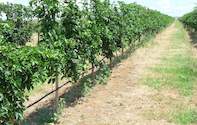Granadillas (Passiflora edulis) are native to tropical regions of the world and appreciate conditions with a relatively high humidity and a rainfall of at least 1 200mm per year. Irrigation - up to 15 litre/plant/day - can supplement low rainfall. Regular watering will keep a granadilla vine flowering and fruiting almost continuously.

The growing temperatures should not exceed 29°C, while minimum temperature should not dip below 5°C. Granadillas are sensitive to frost and cool soil temperatures may cause inter-vein yellowing of the leaves.
Granadillas can be grown from seedlings or seed. To grow from seed, allow fruit pulp (with seeds) to ferment for a few days in a plastic container. Wash to separate seeds from the pulp and sow in well-drained soils with a pH of 6.5 - 7.5. Add agricultural lime to adjust pH upwards.
Avoid compacted or clay soils - deep soil penetration is important. A soil analysis will indicate soil nutrient requirements, but most often phosphate and calcium may be added. Granadillas may also have a zinc and boron deficiency, best addressed in spring with foliar and basal stem sprays.
Planting and Trellising Granadillas
Transplant granadilla seedlings when 40cm tall (after three to six months). Springtime is best for planting it out. A spacing of 1 m by 2 m is optimal.
Due to its climbing nature, trellising of granadillas is essential for optimum growth, ripening and harvesting. Wooden posts of 2 m are used, with the granadillas main shoots growing along wires suspended between the post - similar to vine trellising. Granadillas can also be trained to grow along a wall, practical in a domestic garden but not in a farming setup.
Due to the vigorous and climbing nature of granadillas, pruning is recommended to remove tangles and deadwood. Pruning before the spring flush is best.
Carpenter bees are more effective at pollination than honey bees. Wind pollination is even less effective due to the stickiness and weight of the pollen.
The lifespan of a granadilla is about three years.
Pests and Diseases of Granadillas
The main pest and disease of granadillas are Fusarium wilt, nematodes and crown rot. Nematode damage is visible as stem lesions near the soil line. Footrot is caused by waterlogged soil.
The yellow granadilla is more resistant to wilt and nematodes and is used as a rootstock for the purple variety. Both variants are susceptible to Phytophthora cinnamoni.
Snails attack granadilla leaves and thrips can be a problem on seedlings.
Harvesting Granadillas
The optimum production age of a granadilla vine is 18 months, but the first granadillas may be ready between six and nine months after transplanting the seedlings.
After 18 months two crops can be harvested per year in South Africa. A summer crop is picked from November to January and in winter (June to July) a smaller crop can be harvested. Some granadilla producers in the Northern and Mpumalanga provinces may have a third small harvest in March/April. Purple granadillas ripen earlier than the yellow type.
The yield can vary from 15 tonnes/hectare initially to about 40 tonnes/ha in the second year of production.
Granadillas are picked for the fresh fruit market when skins are light purple. When used for processing such as juicing, the fruit is picked when skins are dark purple. A wax may be applied to the skins to prevent shrivelling and drying.
Granadillas are climacteric fruit i.e. they will continue to ripen after harvesting. Ripe granadillas become sweeter after harvesting, but green granadillas will not ripen fully off the vine. Ripen at room temperature or store in a refrigerator when fully ripe.
By Marinda Louw